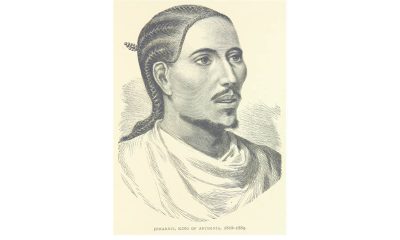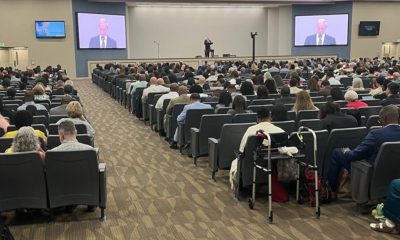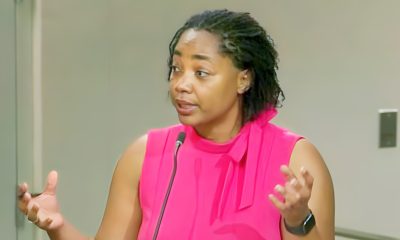Family
Summer Camp Fosters Female Camaraderie and Unity
WASHINGTON INFORMER — For the eighth consecutive summer, a group of elders will channel the spirit of Nannie Helen Burroughs, Anna Julia Cooper and other Black female education pioneers as they equip young ladies with the skills needed to navigate adolescence and womanhood.
By Sam P.K. Collins
For the eighth consecutive summer, a group of elders will channel the spirit of Nannie Helen Burroughs, Anna Julia Cooper and other Black female education pioneers as they equip young ladies with the skills needed to navigate adolescence and womanhood.
This process will unfold throughout June and July during the iThings 2 Collard Greens Summer Camp for Girls. For six weeks, more than a dozen young women will keep their smartphones out of reach as they receive lessons in knowledge of self, ancestral reverence and conflict resolution — all intended to prime them for a lifetime of service.
“This camp is showing our girls how to be of service to their higher selves and community. There’s no technology. They have to turn on their inner technology,” said Kathy English Holt, founder of the iThings 2 Collard Greens Summer Camp for Girls.
Holt started the iThings 2 Collard Greens Summer Camp for Girls in 2001 while battling a serious illness. During her bout, she read about Burroughs and Cooper and learned about a local all-girls boarding school that Burroughs founded in the early 20th century.
That story inspired Holt’s foray into youth enrichment, which manifested in the launch of the iThings 2 Collard Greens Summer Camp for Girls at the Davis Center in Northwest.
That year and every year since, participants in the program learned about altar work, dance, sewing, yoga and nutrition under the auspices of Beatrice Davis Williams, Frances Coles, Bernadine Watson, Joyce Pegues, Free Benjamin, Princess Thompson and others.
Veteran educator Cheryl Shoemaker will continue to serve as camp director as young ladies between the ages of 5 and 13 converging on the Kingsbury Center in Northwest study the 14th Amendment and explore the historical and current impact of Black women in U.S. politics.
“What I found is that when children don’t have anything to do, they get into a lot of mess and fall behind on their school work,” Holt said. “They cannot afford to be idle. Young people trying to babysit young people is also extremely dangerous. Summer should be a time to focus. The youth need to do altar work and spend time [learning about] themselves.”
On May 19, the iThings 2 Collard Greens Summer Camp for Girls will host a benefit concert at Peoples Congregational United Church of Christ in Northwest. Jazz bassist and Holt’s son Corcoran Holt, along with his band The Mecca, will headline this event to raise funds for the summer camp.
The iThings 2 Collard Greens Summer Camp for Girls rolls out amid what many consider treacherous times for Black women and girls.
Within the past few years, more than 75,000 Black women and girls across the country have gone missing in cases that haven’t been heavily publicized. Research from the African American Policy Forum also shows that Black girls often receive harsher treatment from school personnel and law enforcement officials than their counterparts.
In response what Holt described as the harsh language and demeaning decorum she recalled witnessing on public transportation, she molded the iThings 2 Collard Greens Summer Camp for Girls so that enrollees could connect with older women and eventually return the favor as camp counselors.
For Masai Oakes, a former camper and current camp counselor, such a model proved enriching, especially since she had all male siblings in her household.
Years after attending a weeklong retreat with her cohort in a rural South Carolina community. Oakes said she continues to embrace the love for drawing she fostered while in the iThings 2 Collard Greens Summer Camp for Girls.
“This was a camp to go to and feel empowered. Beforehand, I didn’t know or care that much about the importance of being a Black woman,” said Oakes, an 18-year-old college sophomore who lives in Northwest. “Going to this camp [helped me] see a lot of people like me and what we were capable of.
“It’s very important,” she said. “If someone wants a sense of community, the iThings 2 Collard Greens Summer Camp for Girls would be a great place for them.”
This article originally appeared in the Washington Informer.
Antonio Ray Harvey
Lawmakers Incensed by ‘Watering Down’ of Language in Child Sex Solicitation Bill
After an emotional hearing on July 2, the Assembly Public Safety Committee voted to advance Senate Bill (SB) 1414 with an 8-0 vote. The legislation is an anti-sex-trafficking measure designed to increase penalties for those who purchase sex from children, SB 1414, co- authored by Senators Shannon Grove (R-Bakersfield), Anna Caballero (D-Merced) and Senator Susan Rubio (D-Baldwin Park), will be reviewed by the Assembly Appropriations Committee after the Legislature break ends on Aug. 5.

By Antonio Ray Harvey
California Black Media
After an emotional hearing on July 2, the Assembly Public Safety Committee voted to advance Senate Bill (SB) 1414 with an 8-0 vote. The legislation is an anti-sex-trafficking measure designed to increase penalties for those who purchase sex from children,
SB 1414, co- authored by Senators Shannon Grove (R-Bakersfield), Anna Caballero (D-Merced) and Senator Susan Rubio (D-Baldwin Park), will be reviewed by the Assembly Appropriations Committee after the Legislature break ends on Aug. 5.
The legislation has received bipartisan support. However, “critical amendments” were removed, Grove said. She is not satisfied with the language currently in the bill and is pressing members of the Assembly Public Safety Committee to allow key provisions to be restored.
“I am disappointed that they didn’t accept the amendments for all minors to be protected under felony convictions,” Grove said after the committee’s vote.
“I am not going to give up fighting for those 16- and 17-year-olds – and all minors,” Grove stated. “Now, the district attorneys would have to prove two crimes: that they were bought and sold in order to go back to the perpetrator (trafficker) who initiated the whole process.”
SB 1414 made it off the Senate floor with a 36-0 bipartisan vote on May 23. Before the floor vote in the Senate, the Senate Public Safety Committee amended SB 1414, weakening protections for children ages 16 and 17, Grove said.
The committee’s amendments included charging violators who purchase children 15 and under for sex as ‘wobblers’ (crimes that can be punished as a felony or misdemeanor). According to the current language of the bill, solicitation of a 16- and 17-year-old child is only punishable as a misdemeanor. The second amendment to the bill calls for the felony charge to only carry possible jail time — not time in prison.
Grove and her supporters’ other concern is that a third amendment to SB 1414 states that only perpetrators with a previous conviction of buying sex from a child 15 or under, on the second offense and with over a 10-year age gap of the victim, must register as a Tier 1 sex offender.
Dr. Stephany Powell, a retired Los Angeles Police Department sergeant who has over 30 years of sexual exploitation and trafficking experience gained through law enforcement, testified in front of the Assembly Public Safety Committee.
“First of all, there’s no way in the world that (these amendments) are protecting a 16- or 17-year-old,” said Powell, who now assists victims of human trafficking. “Just by the age alone, they are considered to be a victim of human trafficking. That’s your proof right there.”
Assemblymember Kevin McCarty (D-Sacramento), chair of the Public Safety Committee and a member of the California Legislative Black Caucus (CLBC), told Grove that he supports SB 1414 and commended her efforts to bring “more accountability to the sex trade.”
McCarty said he is willing to make SB 1414 “stronger,” but he is not willing to allow Grove to buck the rules of the Legislature to push her amendments through.
“That’s not on the table. As the rules, you know, we can’t go change that,” McCarty said of Grove’s amendments request.
On June 2, Anne Irwin, the founder and director of Smart Justice California, emailed California Black Media (CBM) a statement responding to SB 1414. Smart Justice sides with the amendments made by the Democrats in the Senate and the Assembly.
“With the recently adopted amendments, SB 1414 now represents a smart policy solution that prioritizes the safety and well-being of all minors,” Irwin stated. “By allowing felony prosecutions for solicitation of 16- and 17-year-olds when there is evidence of human trafficking, lawmakers have further improved the bill – which was originally overly broad and would have had harmful unintended consequences.”
Community
Hundreds Come to Jehovah’s Witnesses’ Assembly Hall for Three-Day Program of ‘Good News’ in Fremont
Two weeks into summer’s official start, the Thomas family could have headed to a theme park, the beach, or even visited family for the weekend of July 5-7. Instead, Daniel, Alana, and daughter Tatiana, were looking forward to a three-day convention with a few thousand people who coming to hear exciting good news! “This isn’t just a convention,” said Thomas, of San Jose, CA. “It’s a time to be together as a family and with friends and to be part of a happy and hopeful occasion. It’s also a great way to enjoy a weekend getaway in a wonderful nearby city.”

Special to the Post
Two weeks into summer’s official start, the Thomas family could have headed to a theme park, the beach, or even visited family for the weekend of July 5-7.
Instead, Daniel, Alana, and daughter Tatiana, were looking forward to a three-day convention with a few thousand people who coming to hear exciting good news!
“This isn’t just a convention,” said Thomas, of San Jose, CA. “It’s a time to be together as a family and with friends and to be part of a happy and hopeful occasion. It’s also a great way to enjoy a weekend getaway in a wonderful nearby city.”
One of the largest convention organizations in the world returned to the Fremont Assembly Hall of Jehovah’s Witnesses with a much-anticipated motivational program to comfort and encourage the public.
In a world where bad news endlessly streams on social media, TV and radio, Jehovah’s Witnesses presented their 2024 “Declare the Good News”! convention series which began the weekend of May 24-26 and will run to Sept. 8-10.
The free, three-day live event was expected to draw more than 26,000 attendees to the city of Fremont over the course of 16 weekends – fueling the city’s economy with local spending at stores, hotels and restaurants.
“We are excited once again to bring our venue to Fremont to host our conventions,” said Alan Mobley, local spokesperson for Jehovah’s Witnesses. “These conventions are a highlight of the year for thousands of people who want to experience some positivity in their lives, and we are happy to enjoy the program once again in this hospitable city.”
The “Declare the Good News”! convention presented Bible-based videos, discourses and interviews on topics such as…
- How the Gospels Present an Accurate Record of the Life of Jesus.
- Why We Can Trust the Prophecies About Jesus’ Birth and Childhood.
- Why Millions Today Are Confident and Do Not Fear “Bad News”.
Saturday featured a baptism of candidates from surrounding communities, while a captivated audience viewed a two-part video feature on Friday and Saturday mornings. Prior to each convention, local congregations have engaged in campaigns to invite community members to this free event.
Last year, nearly 13 million people attended more than 6,000, three-day conventions worldwide.
To learn more about this free convention and to find a location near you, please visit jw.org > About Us > Conventions.
Bay Area
Sunday Afternoon at the Marin County Fair
The theme of the Marin County Fair 2024, which ran from July 3-7, was ‘Make a Splash!’ celebrating one of our most precious natural resources — water — and all things water-related, according to the Marin County news release. “Water is especially relevant and important in Marin County” says the website, “whether we use the water for recreation, conserve it during drought times, have concerns about sea level rise, or to care for the local marine life.”

By Godfrey Lee
The theme of the Marin County Fair 2024, which ran from July 3-7, was ‘Make a Splash!’ celebrating one of our most precious natural resources — water — and all things water-related, according to the Marin County news release.
“Water is especially relevant and important in Marin County” says the website, “whether we use the water for recreation, conserve it during drought times, have concerns about sea level rise, or to care for the local marine life.”
The fair educates and entertains the fair-goers with water-related exhibits and competitive exhibits categories. One exhibit displayed the many personal essays that people wrote and contributed on what water meant to them.
Water was also the dominant theme of much of the fine art, and the categories included “watercolors, sea, surf and sand, water birds, drip paintings, and marine mammals, just to name a few.”
According to the news release, community partners told of “the important role water plays in our local environment, from the source of our precious drinking water on Mount Tamalpais and the Novato Creek Watershed to the rising sea along our coast.”
Water-related activities at the fair taught people about watersheds, water conservation, and more.
Much of the fair was the same as years past with headline concerts and side performances, carnival rides and fireworks every night.
The community food booths were closed, which meant that food and drinks could only be brought from the specialty food vendors scattered around the fairgrounds. For dinner, this writer bought a huge barbeque, foot-long, turkey leg, complete with fries and coleslaw, that I could not completely finish eating.
The farm exhibits also seemed empty and a bit smaller without the chickens, due to the concern about Avian Influenza, which can also infect humans.
On Sunday, July 7, as part of Latin Heritage Day, the Community Stage featured local Latin talent from around the Bay including Raya Nova, Area Agresiva, Zazil Haa, Ballet Folklorico Netzahualcoyotl, and Clave MC.
I watched the last main concert, featuring Los Lonely Boys, and left the fair after the fireworks. I enjoyed the fair and will hope to visit again next year, even if I know it will still be more or less the same as before.
-

 Arts and Culture3 weeks ago
Arts and Culture3 weeks agoRooted in Tradition: The Intricate History of Black Hair Braiding
-

 Bay Area4 weeks ago
Bay Area4 weeks ago“I Will Not Be Bullied,” Says Oakland Mayor Sheng Thao
-

 Bay Area2 weeks ago
Bay Area2 weeks agoPG&E Increases Rates While Bay Area Households Are Struggling to Stay Afloat
-

 Business3 weeks ago
Business3 weeks agoGov Newsom: Raising Fast Food Minimum Wage to $20 Pays Off as Jobs Multiply in Industry
-

 Activism4 weeks ago
Activism4 weeks agoOpponents of Mayor Sheng Thao Are Calling on Her to Resign Following FBI Raid
-

 Community1 week ago
Community1 week agoHundreds Come to Jehovah’s Witnesses’ Assembly Hall for Three-Day Program of ‘Good News’ in Fremont
-

 Bay Area2 weeks ago
Bay Area2 weeks agoJuneteenth Mass Shooting Suspect Charge with Multiple Counts of Felony Assault by Alameda County DA Pamela Price
-

 Activism4 weeks ago
Activism4 weeks agoOakland Coliseum Sale to AASEG: A Model for Community Development and Inclusion






















































